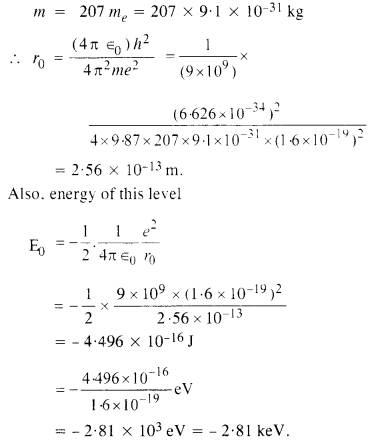NCERT Solved Exercise Questions – Class 12 Physics Chapter 12 Atoms
12.1 Choose the correct alternative from the clues given at the end of the each statement:
(a) The size of the atom in Thomson’s model is ………. the atomic size in Rutherford’s model. (much greater than/no different from/much less than.)
(b) In the ground state of ………. electrons are in stable equilibrium, while in ………. electrons always experience a net force. (Thomson’s model/ Rutherford’s model.)
(c) A classical atom based on ………. is doomed to collapse. (Thomson’s model/ Rutherford’s model.)
(d) An atom has a nearly continuous mass distribution in a ………. but has a highly non-uniform mass distribution in ………. (Thomson’s model/ Rutherford’s model.)
(e) The positively charged part of the atom possesses most of the mass in ………. (Rutherford’s model/both the models.)
Ans –
- no different from
- Thomson’s model; Rutherford’s model.
- Rutherford’s model.
- Thomson’s model, Rutherford’s model.
- both the models.
12.2 Suppose you are given a chance to repeat the alpha-particle scattering experiment using a thin sheet of solid hydrogen in place of the gold foil. (Hydrogen is a solid at temperatures below 14 K.) What results do you expect?
Ans – If a thin sheet of solid hydrogen were substituted for the gold foil in the alpha-particle scattering experiment, the scattering angle would not be sufficient. This is due to the fact that hydrogen’s mass (1.67 x 10^-27 kg) is lower than incident particles’ mass (6.64×10^-27 kg). As a result, the target nucleus’ mass is greater than that of the scattering particle (hydrogen). Therefore, if solid hydrogen is utilised in the -particle scattering experiment, the -particles would not bounce back.
12.3 What is the shortest wavelength present in the Paschen series of spectral lines?
Ans – Integers n1 and n2 are used.
For values n1 = 3 and n2 =∞, the shortest wavelength found in the Paschen series of spectral lines is reported.

12.4 A difference of 2.3 eV separates two energy levels in an atom. What is the frequency of radiation emitted when the atom make a transition from the upper level to the lower level?
Ans – Let v represent the radiation frequency that is released as an atom moves from one level to another.
The relationship for energy is as follows:
E = hv
Where,
Planck’s constant is h.

12.5 The ground state energy of hydrogen atom is –13.6 eV. What are the kinetic and potential energies of the electron in this state?
Ans – E = 13.6 eV is the hydrogen atom’s ground state energy.
This is one atom of hydrogen’s total energy. Kinetic energy is inversely proportional to total energy.
K.E. = -E (Total energy)
= -(-13.6) = 13.6 eV
P.E. = 2 X E = 2 X (-13.6)
= -27.2 eV
12.6 A hydrogen atom initially in the ground level absorbs a photon, which excites it to the n = 4 level. Determine the wavelength and frequency of photon.
Ans – The energy of the hydrogen atom’s ground state is E = 13.6 eV.
This is the total energy of one hydrogen atom. Total energy and kinetic energy are diametrically opposed.


12.7 (a) Using the Bohr’s model calculate the speed of the electron in a hydrogen atom in the n = 1, 2, and 3 levels.
(b) Calculate the orbital period in each of these levels.
Ans – (a) Assuming n1 = 1, let v1 represent the electron’s orbital speed in
the ground state level of a hydrogen atom.
The relation states that 1 is given for charge (e) of an electron.


12.8 The radius of the innermost electron orbit of a hydrogen atom is 5.3×10–11 m. What are the radii of the n = 2 and n =3 orbits?
Ans – We are aware that rn = r0n2, where r0 = 5.3 x 10-u m is the radius of the innermost orbit of the hydrogen atom, gives the radius of the nth orbit of a hydrogen atom.
When n = 2, r2 = 5.3 x 10-u x 4
= 2.12 x 10-10m
When n = 3,
= 5.3 x 10-11 x 9
= 4.77 x 10-10m.
12.9 A 12.5 eV electron beam is used to bombard gaseous hydrogen at room temperature. What series of wavelengths will be emitted?
Ans – It is assumed that the electron beam used to irradiate gaseous hydrogen at normal temperature has an energy of 12.5 eV. Additionally, at ambient temperature, the energy of gaseous hydrogen in its ground state is -13.6 eV.
The energy of gaseous hydrogen changes to -13.6 + 12.5 eV, or -1.1 eV, when it is hit with an electron beam.

12.10 In accordance with the Bohr’s model, find the quantum number that characterises the earth’s revolution around the sun in an orbit of radius 1.5 × 1011 m with orbital speed 3 × 104 m/s. (Mass of earth = 6.0 × 1024 kg.)
Ans – Earth’s orbital radius around the Sun is 1.5 x 10^11 metres.
Earth’s orbital velocity is 3 x 10^4 m/s.
Earth’s mass is 6.0 x10^24 kg.
The quantization of angular momentum in Bohr’s model is as follows:

12.11 Answer the following questions, which help you understand the difference between Thomson’s model and Rutherford’s model better.
(a) Is the average angle of deflection of α-particles by a thin gold foil predicted by Thomson’s model much less, about the same, or much greater than that predicted by Rutherford’s model?
(b) Is the probability of backward scattering (i.e., scattering of α-particles at angles greater than 90°) predicted by Thomson’s model much less, about the same, or much greater than that predicted by Rutherford’s model?
(c) Keeping other factors fixed, it is found experimentally that for small thickness t, the number of α-particles scattered at moderate angles is proportional to t. What clue does this linear dependence on t provide?
(d) In which model is it completely wrong to ignore multiple scattering for the calculation of average angle of scattering of α-particles by a thin foil?
Ans – (a) about the same
Rutherford’s and Thomson’s models anticipate similar sizes for the average angle of deflection of -particles by a thin gold foil. This is so because both models used the same average angle.
(b) much less
Rutherford’s model predicts a far higher chance of -particle scattering than Thomson’s model, which predicts a much lower probability.
(c) According to this, scattering is primarily caused by a single collision because the likelihood of a single collision rises linearly with the quantity of target atoms and, consequently, linearly with the foil’s thickness.
(d) In the Thomson model, the atom’s positive charge is dispersed equally. Thus, a single impact only slightly deflects the object. Only taking into account multiple scattering may account for the observed average scattering angle. It is incorrect to exclude multiple scattering in Thomson’s model as a result.
12.12 The gravitational attraction between electron and proton in a hydrogen atom is weaker than the coulomb attraction by a factor of about 10–40. An alternative way of looking at this fact is to estimate the radius of the first Bohr orbit of a hydrogen atom if the electron and proton were bound by gravitational attraction. You will find the answer interesting.
Ans – h = Planck’s constant = 6.63 × 10−34 Js
me = Mass of an electron = 9.1 × 10−31 kg
e = Charge of an electron = 1.9 × 10−19 C
mp = Mass of a proton = 1.67 × 10−27 kg
By taking into account the electrostatic force between the electrons and the proton in the nucleus, the radius of the first orbit in Bohr’s model is determined.

12.13 Obtain an expression for the frequency of radiation emitted when a hydrogen atom de-excites from level n to level (n–1). For large n, show that this frequency equals the classical frequency of revolution of the electron in the orbit.
Ans – A hydrogen atom naturally de-excites from level n to level n1, which is a given.
The relationship between radiation energy (E1) and level n is as follows:
The formula for an electron’s energy in the nth orbit of a hydrogen atom is


12.14 Classically, an electron can be in any orbit around the nucleus of an atom. Then what determines the typical atomic size? Why is an atom not, say, thousand times bigger than its typical size? The question had greatly puzzled Bohr before he arrived at his famous model of the atom that you have learnt in the text. To simulate what he might well have done before his discovery, let us play as follows with the basic constants of nature and see if we can get a quantity with the dimensions of length that is roughly equal to the known size of an atom (~ 10–10m).
(a) Construct a quantity with the dimensions of length from the fundamental constants e, me, and c. Determine its numerical value.
(b) You will find that the length obtained in (a) is many orders of magnitude smaller than the atomic dimensions. Further, it involves c. But energies of atoms are mostly in non-relativistic domain where c is not expected to play any role. This is what may have suggested Bohr to discard c and look for ‘something else’ to get the right atomic size. Now, the Planck’s constant h had already made its appearance elsewhere. Bohr’s great insight lay in recognising that h, me, and e will yield the right atomic size. Construct a quantity with the dimension of length from h, me, and e and confirm that its numerical value has indeed the correct order of magnitude.
Ans – Charge on an electron, e = 1.6 × 10−19 C
Mass of an electron, me = 9.1 × 10−31 kg
Speed of light, c = 3 ×108 m/s


12.15 The total energy of an electron in the first excited state of the hydrogen atom is about –3.4 eV.
(a) What is the kinetic energy of the electron in this state?
(b) What is the potential energy of the electron in this state?
(c) Which of the answers above would change if the choice of the zero of potential energy is changed?
Ans – (a) Total energy of the electron, E = −3.4 eV
Kinetic energy of the electron is equal to the negative of the total energy.
K.E. = -E = – (-3.4 eV) = 3.4 eV
E. = 2E = 2 x (-3.4 eV)
= -6.8 eV
(b)The selection of zero potential energy has no bearing on kinetic energy. As a result, its worth doesn’t alter. However, as the zero levels of potential energy vary, the potential energy also changes.
(c) The reference point used affects a system’s potential energy. Here, the reference point’s potential energy is assumed to be zero. The system’s potential energy value will change if the reference point is altered. The system’s total energy will vary because total energy is the sum of kinetic and potential energies.
12.16 If Bohr’s quantisation postulate (angular momentum = nh/2π) is a basic law of nature, it should be equally valid for the case of planetary motion also. Why then do we never speak of quantisation of orbits of planets around the sun?
Ans – Due to the fact that the angular momentum associated with planetary motion is highly dependent on the value of Planck’s constant, we never discuss quantization of planets’ orbits around the Sun (h). The Earth’s orbital angular momentum is on the order of 10^70h. As a result, quantum levels n reach extremely high values of the order of 10^70. Successive energies and angular momenta are comparatively quite tiny for large values of n. The quantum levels for planetary motion are therefore thought of as continuous.

12.17 Obtain the first Bohr’s radius and the ground state energy of a muonic hydrogen atom [i.e., an atom in which a negatively charged muon (µ– ) of mass about 207me orbits around a proton].
Ans – The nth orbit’s radius in Bohr’s model is

A proton and a negatively charged muon (-) with a mass of 207 me are revolving inside the muonic hydrogen atom in question.
As a result, the radius of the electron and muon can be expressed as






